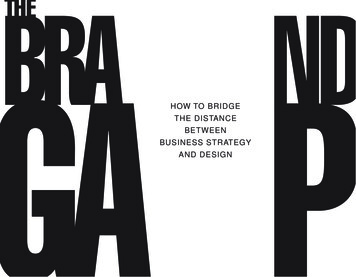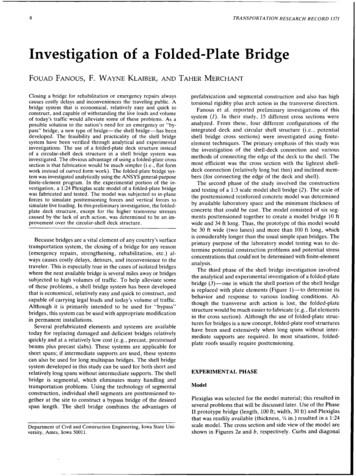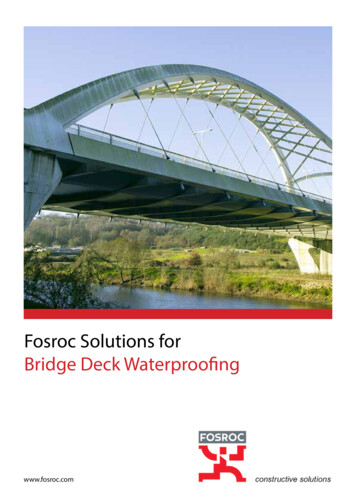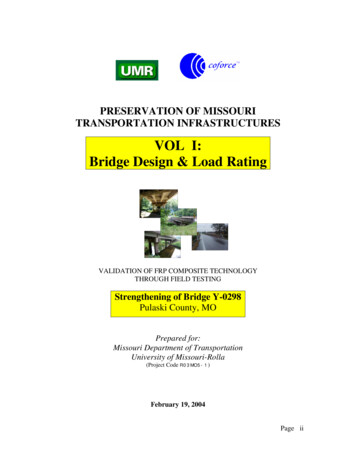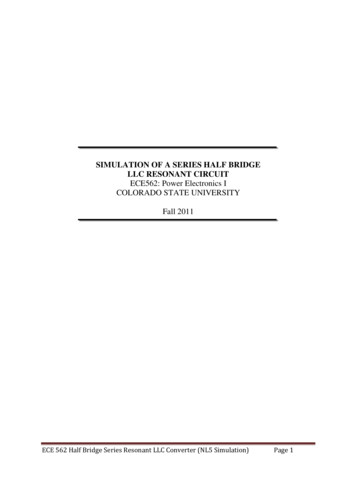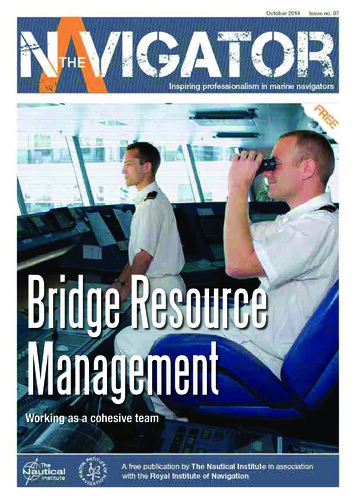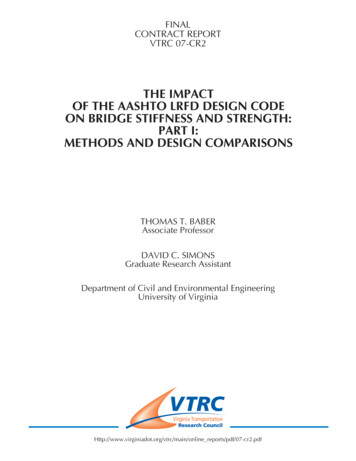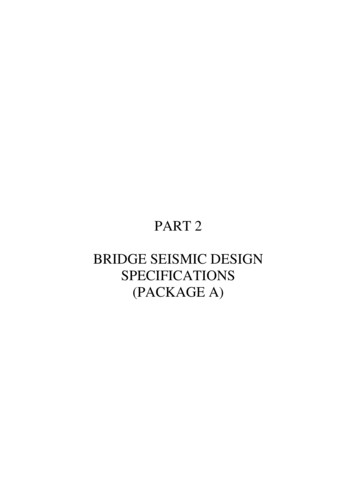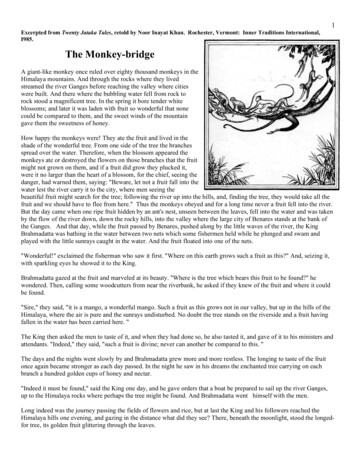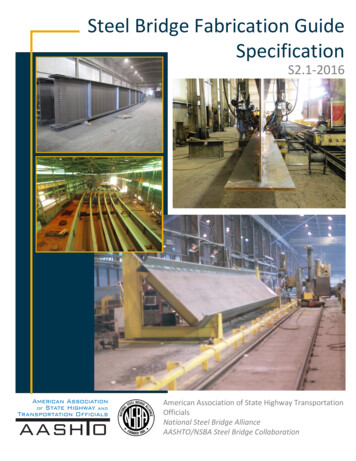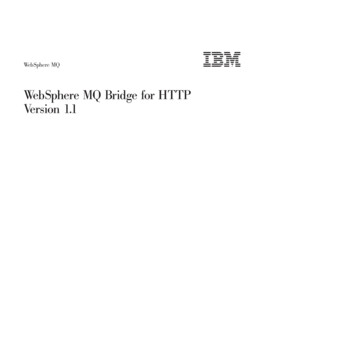
Transcription
WebSphere MQWebSphere MQ Bridge for HTTPVersion 1.1
WebSphere MQWebSphere MQ Bridge for HTTPVersion 1.1
NoteBefore using this information and the product it supports, be sure to read the general information under notices at the backof this book.Second edition (January 2008)This edition of the book applies to the following SupportPac:v IBM WebSphere MQ Bridge for HTTP (SupportPac MA0Y) Version 1.1and to all subsequent releases and modifications until otherwise indicated in new editions. Copyright International Business Machines Corporation 2007, 2008. All rights reserved.US Government Users Restricted Rights – Use, duplication or disclosure restricted by GSA ADP Schedule Contractwith IBM Corp.
ContentsFigures . . . . . . . . . . . . . . . vTables . . . . . . . . . . . . . . . viiChapter 1. Introduction . . . . . . . . 1Chapter 2. Preparing to install . . . . . 3Security considerations . 3Chapter 3. Installing . . . . . . . . . 5Chapter 4. Configuring WebSphere MQBridge for HTTP . . . . . . . . . . . 7Chapter 5. Constructing HTTP requestsand handling HTTP responses . . . . . 9Overview of the WebSphere MQ Bridge for HTTP .URI Format . . . . . . . . . . . . .WebSphere MQ Bridge for HTTP verbs . . . .HTTP POST . . . . . . . . . . . .HTTP GET . . . . . . . . . . . . Copyright IBM Corp. 2007, 2008. 911111212HTTP DELETE . . .HTTP headers . . . .Entity headers . . .Request headers . . .Standard HTTP headersSupported message types .131414212425Chapter 6. WebSphere MQ Bridge forHTTP Samples . . . . . . . . . . . 27Installing the WebSphere MQ Bridge for HTTPsamples . . . . . . . . . . . . .Running the WebSphere MQ Bridge for HTTPconsole samples . . . . . . . . . . .Running the WebSphere MQ Bridge for HTTPweb-based sample . . . . . . . . . . 27. 28. 29Chapter 7. Limitations . . . . . . . . 31Chapter 8. HTTP Return codes . . . . 33Notices . . . . . . . . . . . . . . 37iii
ivWebSphere MQ: WebSphere MQ Bridge for HTTP Version 1.1
Figures1.2.3.4.Introduction to WebSphere MQ Bridge forHTTP . . . . . . . . . . . . . . . 1Simple example of a HTTP POST request to aqueue . . . . . . . . . . . . . . . 9Simple example of a HTTP POST response (thePOST is to a queue) . . . . . . . . . . 9Simple example of a HTTP DELETE request toa queue . . . . . . . . . . . . . . 10 Copyright IBM Corp. 2007, 20085.6.7.Simple example of a HTTP DELETE response(the DELETE is to a queue) . . . . . . . 10Simple example of a HTTP GET request to aqueue . . . . . . . . . . . . . . 10Simple example of a HTTP GET response (theGET is to a queue) . . . . . . . . . . 11v
viWebSphere MQ: WebSphere MQ Bridge for HTTP Version 1.1
Tables1.2.3.4.WebSphere MQ Bridge for HTTP verbs . . . 1Headers that are supported in HTTP requestmessages . . . . . . . . . . . . . 15Headers that can be received in responsemessages . . . . . . . . . . . . . 15Headers that are supported in HTTP requestmessages . . . . . . . . . . . . . 21 Copyright IBM Corp. 2007, 20085.6.7.Mapping content-type and x-msg-class tomessage types. . . . . . . . . . .Mapping message types to x-msg-class andcontent-type . . . . . . . . . . . . . . . . . . . . . . . . . 25. 26. 33vii
viiiWebSphere MQ: WebSphere MQ Bridge for HTTP Version 1.1
Chapter 1. IntroductionThis document is about the IBM WebSphere MQ Bridge for HTTP SupportPac (referred to in this document as the WebSphere MQ Bridge for HTTP). ThisSupportPac enables client applications to exchange messages with WebSphere MQfrom any platform or language with HTTP capabilities without the need for aWebSphere MQ client. The WebSphere MQ Bridge for HTTP is not suitable for usewith messages where guaranteed delivery is required.BenefitsThis SupportPac will be of benefit to you if:v you have environments that you want to connect to WebSphere MQ that are notsupported but that can build HTTP requests and handle responses.v you have environments that you want to connect to WebSphere MQ, but thathave insufficient storage space to install a WebSphere MQ client.v you have multiple systems that you want to connect to WebSphere MQ but itwould take too long to install the WebSphere MQ client on all of those systems.v you want to access a WebSphere MQ infrastructure from a web-basedapplication.v you want to enhance existing web-based applications, using asynchronoustechniques such as AJAX to enhance interactivity.HTTP support can be used with both point-to-point and publish/subscribemessaging topologies.How does HTTP support work?J2EE 1.4Application ServerHTTPClientWebSphereMQ Bridgefor HTTPWebSphereMQFigure 1. Introduction to WebSphere MQ Bridge for HTTPAs figure one shows, the purpose of the WebSphere MQ Bridge for HTTP is toreceive HTTP requests from one or more clients, interact with WebSphere MQ ontheir behalf and return HTTP responses to them.The WebSphere MQ Bridge for HTTP consists of a J2EE servlet that is connected toWebSphere MQ via a resource adapter. The HTTP servlet is capable of handling 3different types of HTTP requests; POST, GET and DELETE.Table 1. WebSphere MQ Bridge for HTTP verbsHTTP RequestResultPOSTPuts a message on a queue or topic. Copyright IBM Corp. 2007, 20081
Table 1. WebSphere MQ Bridge for HTTP verbs (continued)HTTP RequestResultGETBrowses the first message on a queue. Inline with the HTTP protocol this does notdelete the message from the queue. Thisverb cannot be used with publish/subscribemessaging.DELETEBrowses and deletes a message from aqueue or topic.More information about how to construct HTTP requests and handle HTTPresponses from the WebSphere MQ Bridge for HTTP, is given in Chapter 4.2WebSphere MQ: WebSphere MQ Bridge for HTTP Version 1.1
Chapter 2. Preparing to installPrerequisitesThis WebSphere MQ Bridge for HTTP can be used with WebSphere MQ Version6.0.2.1 or later. It is not necessary for WebSphere MQ to be installed on the samemachine as the WebSphere MQ Bridge for HTTP.In order to make use of the WebSphere MQ Bridge for HTTP you will requiresome additional software.Where you install the WebSphere MQ HTTP Bridge you will require:v a J2EE 1.4 compliant application server.v a WebSphere MQ JMS provider within your application server.– If you are using WebSphere Application Server (WAS) Version 6 or earlier usethe WAS Message Listener Port (MLP) to integrate WebSphere MQ as the JMSprovider.– If you are using an application server other than WAS, use the WebSphereMQ resource adapter. This is included in WebSphere MQ Version 6.0.2.1.Clients that use the WebSphere MQ Bridge for HTTP must be capable of creatingHTTP requests and receiving HTTP responses.ma0y.install.zipThe WebSphere MQ Bridge for HTTP is delivered as a zip file, ma0y.install.zip andincludes:v this document (ma0y.pdf)v a readme.txtv a WMQHTTP.warv a licenses folder containing product licenses and notices.txtSecurity considerationsClient connection authorityConnections between HTTP clients and the application server should be secured atthe web container level. It is the responsibility of the administrator of the J2EEapplication server to secure the WebSphere MQ Bridge for HTTP servlet usingstandard HTTP server techniques. How you secure the connections will be specificto you application server, refer to your application server’s documentation forinformation.Resource adapter connection to WebSphere MQHow you secure the connection between you resource adapter and WebSphere MQis dependent on your specific resource adapter, refer to your resource adapter’sdocumentation for more information regarding security.Consideration of what user authorizations are required to initially connect to theWebSphere MQ system from the JMS provider is required. Copyright IBM Corp. 2007, 20083
The resource adapter will connect to WebSphere MQ using a single authorizationID. The user ID used to connect the resource adapter to WebSphere MQ must havethe correct WebSphere MQ authorities. In addition, ensure that the user ID used toconnect your resource adapter to WebSphere MQ has appropriate authorities forconnecting to the relevant queues and topics. Ensure that this user ID does nothave unnecessary permissions on the queue manager you are connecting to.4WebSphere MQ: WebSphere MQ Bridge for HTTP Version 1.1
Chapter 3. InstallingTo install the WebSphere MQ Bridge for HTTP complete the following steps.1. Download the SupportPac ma0y.install.zip file from the WebSphere MQSupportPac website.2. Before extracting the files from ma0y.install.zip, read the license file in thelicenses subdirectory. This license file is supplied in several languages. Ensurethat you are prepared to comply with the terms of the license before youcontinue to install.3. Extract the files from ma0y.install.zip file into a clean directory of your choice.For example c:\Program Files\IBM\WebSphere MQ HTTP.4. Optional: The Servlet is pre-configured with a default maximum wait time forHTTP GET and DELETE requests of 35000 milliseconds. For more informationabout wait times when specified in HTTP GET/DELETEs see “Entity headers”on page 14. Before deploying the Servlet to your application server you canchange this value by modifying the maximum wait time parameter in theweb.xml file inside the Servlet. If you remove this parameter from web.xml, theServlet will also use a maximum wait time of 5000 milliseconds. If yourapplication server allows, you can set the maximum wait time parameter inyour deployment plan and override the value set in web.xml. Not allapplication servers will recognize parameters set in a deployment plan, formore information about your specific application server, refer to yourapplication server’s documentation.5. Optional: When deploying the Servlet to your application server a context-rootforms part of the URI used to send HTTP requests, for more information see“URI Format” on page 11. Depending on your application server this can beconfigured either in your deployment plan or your application server’sadministration console. A sample deployment plan for use with WAS CE isprovided in the samples material and includes an example of how to define acontext-root. For more information refer to Chapter 6, “WebSphere MQ Bridgefor HTTP Samples,” on page 276. Deploy the WMQHTTP.war file from the unzipped ma0y.install.zip to yourapplication server. For instructions about how to do this refer to yourapplication server’s documentation.If you are not using WebSphere Application Sever with the MLP as yourWebSphere MQ JMS provider, you can use the WebSphere resource adapter asyour WebSphere MQ JMS provider. The WebSphere MQ resource adapter isincluded in WebSphere MQ Version 6.0.2.1. Refer to your application server’sdocumentation for information about how to deploy the resource adapter. Youmust have a JMS connection configured from your application server to WebSphereMQ before you proceed to use the WebSphere MQ Bridge for HTTP. Copyright IBM Corp. 2007, 20085
6WebSphere MQ: WebSphere MQ Bridge for HTTP Version 1.1
Chapter 4. Configuring WebSphere MQ Bridge for HTTPAfter installing the WebSphere MQ Bridge for HTTP and deployingWMQHTTP.war to your application server, configure the WebSphere MQ Bridgefor HTTP to use your connection factory.To enable the WebSphere MQ Bridge for HTTP to communicate with WebSphereMQ, configure your application server by specifying the connection factory youwant to use.If you are using the WebSphere MQ resource adapter as your WebSphere MQ JMSprovider, complete the following steps:1. Locate and open your deployment plan. The deployment plan you use todeploy your resource adapter will be specific to the application server you areusing. If you chose to download the WebSphere MQ Bridge for HTTP samples,a sample deployment plan for use with WebSphere Application ServerCommunity Edition is included in the zip file as an example.2. Define a resource called jms/WMQHTTPJCAConnectionFactory with a value ofthe name of your ConnectionFactory object. Ensure that yourConnectionFactory is configured with the name of the WebSphere MQ queuemanager that you want to connect to, if a user ID is required to access thatqueue manager ensure that this is configured on your ConnectionFactory.If you are using WebSphere Application Server MLP, complete the following step:1. Using the WebSphere Application Server admin console, create aConnectionFactory object called jms/WMQHTTPJCAConnectionFactory. Forinformation about how to do this refer to the WebSphere Application Serverinformation center, 6r0/index.jsp?/topic /com.ibm.websphere.express.doc/info/exp/ae/tmm ep.html.If a connection factory called jms/WMQHTTPJCAConnectionFactory does not existwhen the Servlet is invoked for the first time (when it receives the first HTTPrequest), an MQHTTP00002 error will occur and will be logged in you applicationserver error log.To confirm that the WebSphere MQ Bridge for HTTP in installed and configuredcorrectly, in a web-browser navigate to http://hostname:port/context root/msg/queue/myqueue, where myqueue is an empty WebSphere MQ queue. HTTP error504 ’Message retrieval timed out’ will be displayed in the browser window if theWebSphere MQ Bridge for HTTP and JMS resource adapter are configuredcorrectly. Copyright IBM Corp. 2007, 20087
8WebSphere MQ: WebSphere MQ Bridge for HTTP Version 1.1
Chapter 5. Constructing HTTP requests and handling HTTPresponsesThe purpose of the WebSphere MQ Bridge for HTTP is to receive HTTP requestsfrom clients, interact with WebSphere MQ as instructed in those requests and toreturn HTTP responses to the client. This section of the documentation explains theformat of the messages, the information they must contain, and the operations theWebSphere MQ Bridge for HTTP enables you to perform.Overview of the WebSphere MQ Bridge for HTTPSome examples of HTTP response and request messages are included in thissection to help illustrate the interaction between the HTTP client and WebSphereMQ.HTTP POSTTo put a message to a queue, the client creates an HTTP request. This can be doneusing an HTTP client tool, for example, AJAX or Java HTTP libraries.The figure below shows an HTTP request to put a message on a queue calledmyQueue. This request contains the HTTP header x-msg-correlId to set thecorrelation ID of the WebSphere MQ message.POST /msg/queue/myQueue/ HTTP/1.1Host: www.mqhttpsample.comContent-Type: text/plainx-msg-correlID: 1234567890Content-Length: 50Here’s my message body that will appear on the queue.Figure 2. Simple example of a HTTP POST request to a queueThe figure below shows the response sent back to the client. Note that there is noresponse content.HTTP/1.1 200 OKDate: Wed, 2 Jan 2007 22:38:34 GMTServer: Apache-Coyote/1.1 WMQ-HTTP/1.1 JEE-Bridge/1.1Content-Length: 0Figure 3. Simple example of a HTTP POST response (the POST is to a queue)HTTP DELETETo delete a message from a queue the client creates an HTTP request. This can bedone using an HTTP client tool, for example, AJAX or Java HTTP libraries.The figure below shows an HTTP request to delete the next message on queuecalled myQueue. When deleting a message, the message body is sent to the client inthe response and in WebSphere MQ terms is a destructive get. This examplerequest contains the HTTP header x-msg-wait to instruct the server how long to Copyright IBM Corp. 2007, 20089
wait for a message to arrive on the queue, and the x-msg-require-headers header tospecify that the client wants to receive the message correlation ID in the response.DELETE /msg/queue/myQueue/ HTTP/1.1Host: www.mqhttpsample.comx-msg-wait: 10x-msg-require-headers: correlIDFigure 4. Simple example of a HTTP DELETE request to a queueThe figure below shows the response sent back to the client. The correlation ID isreturned to the client as requested in the require-headers header of the request.HTTP/1.1 200 OKDate: Wed, 2 Jan 2007 22:38:34 GMTServer: Apache-Coyote/1.1 WMQ-HTTP/1.1 JEE-Bridge/1.1Content-Length: 39Content-Type: text/plain; charset utf-8x-msg-correlId: 1234567890My message the was lying on the queue.Figure 5. Simple example of a HTTP DELETE response (the DELETE is to a queue)HTTP GETTo get a message from a queue, the client creates an HTTP request. This can bedone using an HTTP client tool, for example, AJAX or Java HTTP libraries. After amessage has been got from a queue it will remain on the queue, in WebSphere MQterms this operation is a browse.The figure below shows an HTTP request for the next message on queue calledmyQueue. This request contains the HTTP headers x-msg-wait to instruct the serverhow long to wait for a message to arrive on the queue and thex-msg-require-headers to specify that the clients wants to receive the messagecorrelation ID in the response.GET /msg/queue/myQueue/ HTTP/1.1Host: www.mqhttpsample.comx-msg-wait: 10x-msg-require-headers: correlIDFigure 6. Simple example of a HTTP GET request to a queueThe figure below shows the response sent back to the client. The correlation ID isreturned to the client as requested in the require-headers head of the request.10WebSphere MQ: WebSphere MQ Bridge for HTTP Version 1.1
HTTP/1.1 200 OKDate: Wed, 2 Jan 2007 22:38:34 GMTServer: Apache-Coyote/1.1 WMQ-HTTP/1.1 JEE-Bridge/1.1Content-Length: 39Content-Type: text/plain; charset utf-8x-msg-correlId: 1234567890My message the was lying on the queue.Figure 7. Simple example of a HTTP GET response (the GET is to a queue)The examples above POST, GET and DELETE messages to and from WebSphereMQ queues. You can also POST and DELETE messages to and from topics bychanging the /msg/queue/myQueue/ URI in the request to /msg/topic/myTopic/.GET is not supported for use with publish/subscribe messaging.For more information about HTTP verbs see section “WebSphere MQ Bridge forHTTP verbs.”URI FormatThe IBM WebSphere MQ Bridge for HTTP is deployed within a J2EE server usinga context-root that you define when you deploy the Servlet to your applicationserver. The bridge is configured such that all requests to the following URIs arehandled by the bridge.v For point to point messaging context root/msg/queue where context root is asdefined in your deployment plan.v For pub/sub messaging context root/msg/topic where context root is as definedin your deployment plan.The URI format supported by WebSphere MQ Bridge for HTTP is as follows:Wmq-http-iri "http:" "//" connection-name "/" wmq-destconnection-name [ tcp-connection-name ]tcp-connection-name ihost [ ":" port ]wmq-dest queue-dest / topic-destqueue-dest "msg/queue/" wmq-resource [ "@" wmq-qmgr ] "/"topic-dest "msg/topic/" wmq-resource "/"Notes:1. If a questions mark, (?) character is used in a wmq-dest it must be substitutedwith ’%3f’, for example, orange?topic should be specified as orange%3ftopic.Note: @wmq-qmgr is only valid on a POST.WebSphere MQ Bridge for HTTP verbsThe 3 verbs that you can use in HTTP requests that are sent to the WebSphere MQBridge for HTTP are:v POSTv GETv DELETEChapter 5. Constructing HTTP requests and handling HTTP responses11
Throughout this section there are references to the WebSphere MQ Bridge forHTTP headers, for more information about these see “HTTP headers” on page 14.HTTP POSTDescriptionUsing the HTTP POST operation you can put a message onto a WebSphere MQqueue or topic. The WebSphere MQ Bridge for HTTP will put messages to queuesand topics as WebSphere MQ messages, as a result of this, they do not have aRFH2 folder.You can use HTTP headers in your HTTP POST request to:v set the properties of the message that is put to WebSphere MQ.v you can use the require-headers header to specify what information about theWebSphere MQ message you would like to receive as headers in the responsemessage.If the HTTP POST request is successful, the entity of the response message will beempty and the content-length of the response will be set to zero. The status code of
download the WebSphere MQ Bridge for HTTP samples, a sample deployment plan for use with WebSphere Application Server Community Edition is included in the zip file as an example. 2. Define a resource called jms/WMQHTTPJCAConnectionFactory with a value of the name of your ConnectionFactory obj

